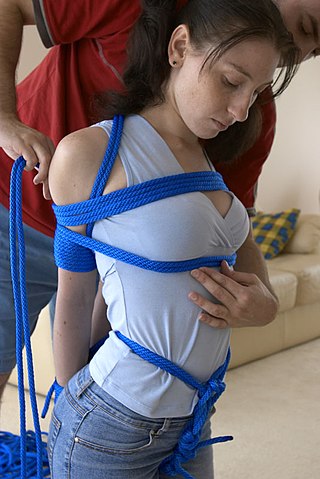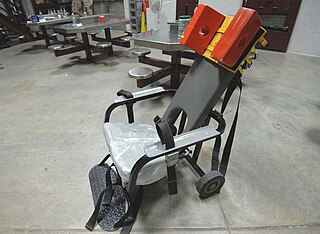
Bondage, in the BDSM subculture, is the practice of consensually tying, binding, or restraining a partner for erotic, aesthetic, or somatosensory stimulation. A partner may be physically restrained in a variety of ways, including the use of rope, cuffs, bondage tape, or self-adhering bandage.

Physical restraint refers to means of purposely limiting or obstructing the freedom of a person's bodily movement.

Handcuffs are restraint devices designed to secure an individual's wrists in proximity to each other. They comprise two parts, linked together by a chain, a hinge, or rigid bar. Each cuff has a rotating arm which engages with a ratchet that prevents it from being opened once closed around a person's wrist. Without the key, the handcuffs cannot be removed without specialist knowledge, and the handcuffed person cannot move their wrists more than a few centimetres or inches apart, making many tasks difficult or impossible.

A hinge is a mechanical bearing that connects two solid objects, typically allowing only a limited angle of rotation between them. Two objects connected by an ideal hinge rotate relative to each other about a fixed axis of rotation, with all other translations or rotations prevented; thus a hinge has one degree of freedom. Hinges may be made of flexible material or moving components. In biology, many joints function as hinges, such as the elbow joint.

Bondage cuffs are restraints designed for use in sexual bondage situations. Compared to conventional handcuffs, they are wide wrist and ankle restraints generally made of leather, often padded with soft leather or fake fur. Bondage cuffs may be fastened at the wrists and/or ankles by a locking mechanism, by a buckle or by velcro. They are secured around the wrist or ankle, and the cuffs may then be attached to each other or another object.

A chain gang or road gang is a group of prisoners chained together to perform menial or physically challenging work as a form of punishment. Such punishment might include repairing buildings, building roads, or clearing land. The system was notably used in the convict era of Australia and in the Southern United States. By 1955 it had largely been phased out in the U.S., with Georgia among the last states to abandon the practice. North Carolina continued to use chain gangs into the 1970s. Chain gangs were reintroduced by a few states during the "get tough on crime" 1990s: in 1995 Alabama was the first state to revive them. The experiment ended after about one year in all states except Arizona, where in Maricopa County inmates can still volunteer for a chain gang to earn credit toward a high school diploma or avoid disciplinary lockdowns for rule infractions.

Bondage in BDSM, is the activity of tying or restraining people using equipment such as chains, cuffs, or collars for mutual erotic pleasure. According to the Kinsey Institute, 12% of females and 22% of males respond erotically to BDSM.

The Justice Prisoner and Alien Transportation System (JPATS), nicknamed "Con Air", is a United States Marshals Service airline charged with the transportation of persons in legal custody among prisons, detention centers, courthouses, and other locations. It is the largest prison transport network in the world. Though primarily used by the Federal Bureau of Prisons or U.S. Immigration and Customs Enforcement, JPATS also assists military and state law enforcement.

A body belt is any waist belt which has D-rings or other attachment points. The belts can be used as medical restraints in institutions for bed and wheelchair restraints, and for safety in activities such as abseiling or construction work. When they are used in sexual bondage plays they are commonly referred to as bondage belts, and also worn in fetish clothing. The belts are usually fastened with buckles and some by a locking mechanism, which enables quick release.
Thomas Solomon is an American escape artist and magician.

Bilboes are iron restraints normally placed on a person's ankles. They have commonly been used as leg shackles to restrain prisoners for different purposes until the modern ages. Bilboes were also used on slave ships, such as the Henrietta Marie. According to legend, the device was invented in Bilbao and was imported into England by the ships of the Spanish Armada for use on prospective English prisoners. However, the Oxford English Dictionary notes that the term was used in English well before then.

Speedcuffs are a model of handcuff characterised by their rigid grip between the two ratchet cuffs. Their rigid design and the inclusion of a grip makes them effective for gaining control over a struggling prisoner, even if only one cuff has been applied. They are standard issue for most police forces within the United Kingdom.

A chain is a serial assembly of connected pieces, called links, typically made of metal, with an overall character similar to that of a rope in that it is flexible and curved in compression but linear, rigid, and load-bearing in tension. A chain may consist of two or more links. Chains can be classified by their design, which can be dictated by their use:
Hope v. Pelzer, 536 U.S. 730 (2002), was a United States Supreme Court case in which the Court ruled that the defense of qualified immunity, under which government actors may not be sued for actions they take in connection with their offices, did not apply to a lawsuit challenging the Alabama Department of Corrections's use of the "hitching post", a punishment whereby inmates were immobilized for long periods of time.

Prisoner transport is the transportation of prisoners by law enforcement agencies or contractors.

A police duty belt is a belt, typically constructed of nylon or leather used by police, prison and security officers to carry equipment easily in a series of pouches attached to the belt, in a readily-accessible manner, while leaving the hands free to interact. This belt can carry any number of useful items, ranging from handcuffs to guns.

A prisoner transport vehicle, informally known as a "Sweat Box" or “Court Bus” amongst British prisoners, is a specially designed or retrofitted vehicle, usually a van or bus, used to transport prisoners from one secure area, such as a prison or courthouse, to another. Less commonly, aircraft, railcars or vessels are also similarly fitted. These vehicles must be highly protected and may feature bars or wire mesh over the windows, bulletproof glass, segregated prisoner compartments, and additional seating for escorting officers.
A belly chain is a physical restraint worn by prisoners, consisting of a chain around the waist, to which the prisoner's hands may be chained or cuffed. Sometimes the ankles are also connected by means of longer chains.

A restraint chair is a type of physical restraint that is used to force an individual to remain seated in one place to prevent injury and harm to themselves or others. They are commonly used in prisons for violent inmates and hospitals for out of control patients. However, they have also been used to restrain prisoners at Guantanamo Bay detention camp during force-feeding.
The use of shackles or restraints on pregnant women is a common practice in prisons and jails in the United States. Shackling is defined as "using any physical restraint or mechanical device to control the movement of a prisoner's body or limbs, including handcuffs, leg shackles, and belly chains". For females, shackles or handcuffs are placed around the ankles, wrists, or around the stomach. The shackling of pregnant women occurs while they are transported within a facility, transported to a hospital, and/or during and after childbirth. Restraints are also used on detained pregnant women in immigration detention facilities.






















